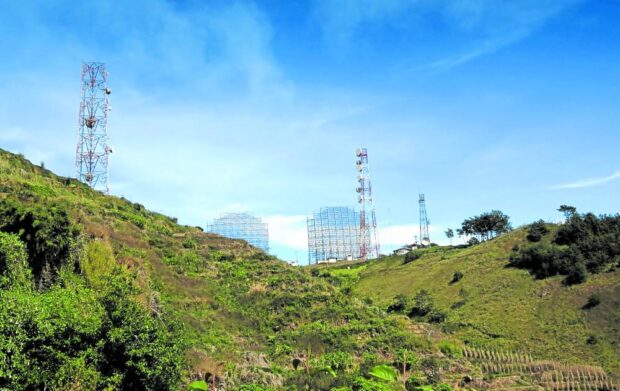DICT eyes TV signals to boost internet reach in Cordillera

TOWERS These transmitter towers and radar dishes on Mt. Cabuyao in Baguio City, as shown in this photo taken in 2014, are often jokingly referred to as the summer capital’s air conditioners. But these towers, which broadcast television shows, may also help improve internet access in Baguio and other mountainous areas of the Cordillera. —EV ESPIRITU
BAGUIO CITY—The Department of Information and Communications Technology (DICT) plans to boost the internet reach in the Cordillera using television signals broadcast from the Mt. Cabuyao peak along the Santo Tomas forest reservation here to transmit data.
The mountain terrain blocks or diminishes communication signals in most Cordillera localities, so the DICT will tap the underutilized broadcast frequency used by television and radio stations, called “white space,” to open new internet access for remote communities, said Allan Lao, DICT technical operations division chief in the Cordillera, on Thursday.
Currently, only 28 percent of the local governments in the region have “decent access to the internet” but this will likely change once government engineers start transmitting data using the television signals, Lao said.
“White space is a frequency that is dormant and not being used by FM radio stations and TV stations,” he said during a science briefing organized at Saint Louis University on Friday.
The DICT will set up internet-boosting devices at the giant radar shields and broadcast towers that tourists often see as they drive up to this city to establish “proof of concept” before the innovation can be replicated in other highland towns.
Article continues after this advertisementThe telecommunication towers, as well as the radar post of the weather bureau, are located in Mt. Cabuyao, just below Mt. Santo Tomas, both of which are part of the Santo Tomas Forest reservation straddling Baguio and neighboring town of Tuba in Benguet province.
Article continues after this advertisementSome of the communication equipment at the Cabuyao peak was introduced by American engineers to serve its military bases, including the former Camp John Hay Air Station.
Testing for sustainability
Lao said DICT contractors would test if data sent via television waves will be sustainable in spite of Baguio’s mostly windy and wet weather and hilly terrain.
“Let us see what happens [to data sent via white space] when typhoons come and when Baguio weather is not good,” he said.
The DICT is also testing internet protocol radio technology, which transmits voice data over radio frequencies, for as long as the transmitting and receiving devices are in the same “line of sight,” Lao said.
White space resolves the “line of sight” problem because television frequencies penetrate hills and walls. One antenna alone can serve areas within a 10-kilometer radius, he said.
Lao said test devices would also be installed at the Lucaben National High School in the Benguet province’s vegetable town of Bakun.
“We will use Mt. Santo Tomas to broadcast data all the way to Lucaben. We have towers in Mankayan town (also in Benguet, which could receive the transmissions from Lucaben in Baku),” Lao said.
White space could speed up wireless connectivity all the way to Kalinga province.
He said local governments have the finances to put up their own communication towers, so they could distribute access to their respective localities.
“It could be the fastest way to speed up internet service” in mountainous regions although fiber optic cables are still the most efficient means to access the internet, Lao said.
Almost complete
The use of broadcast frequency for internet access is part of the national broadband program, said Lao.At present, Lao said phase one of the country’s optic cabling project is about 90 percent completed, including the submarine fiber optic connection at Baler town in Aurora province and the Luzon bypass fiber optic cable that links to San Fernando City in La Union province.
“We partnered with the National Grid Corporation of the Philippines (NGCP) to use their existing fiber optic line… to connect it to Laoag City in Ilocos Norte province in the north and Manila in the south,” Lao said.
Lao said fiber cables from the NGCP lines at Bauang town, also in La Union, will link up with NGCP in Benguet’s capital town of La Trinidad, and connect with the DICT office in Baguio.
—VINCENT CABREZA
READ: Television remains leading source of information on politics in PH — Pulse Asia